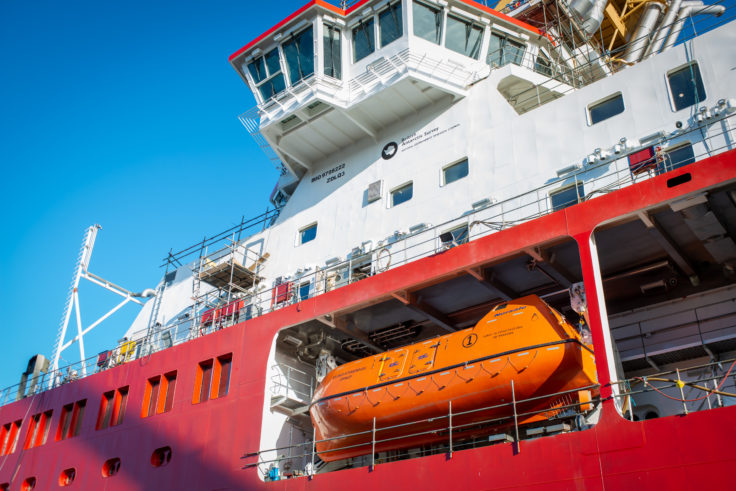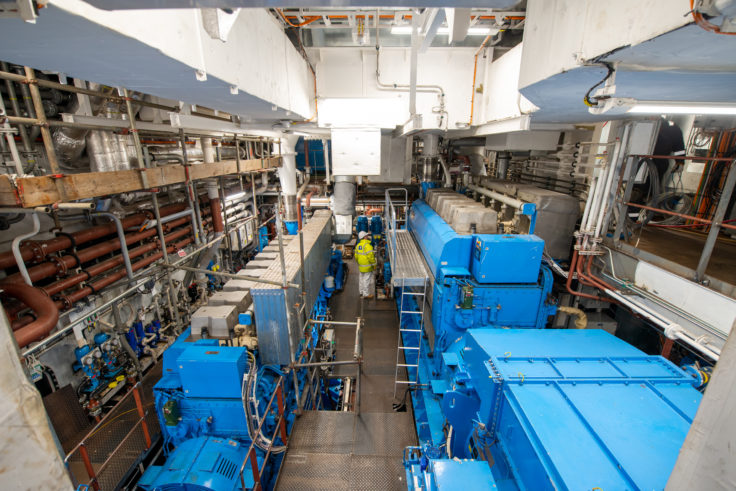RRS Sir David Attenborough latest milestones
BIRKENHEAD. The RRS Sir David Attenborough achieved two important milestones at Cammell Laird’s shipyard this month with the commissioning and testing of lifeboats and power systems. The ship is in the final stages of construction.
One of the most advanced vessels of its type in the world, the new polar research ship for Britain will transform how ship-borne science is carried out in the Polar Regions. It is capable of breaking through ice one metre thick at a speed of 3 knots, and will allow up to 30 crew members, plus 60 scientists and support staff, to access some of the most remote locations on the planet.
Lifeboats secured for sea
The lifeboats, each capable of carrying 90 people, are now in position on both sides of the vessel, along with the operational davits that allow for the safe deployment and recovery of the boats.
RRS Sir David Attenborough is the first International Maritime Organisation’s Polar Code-compliant ship to be built in the UK. These regulations extend to the ship’s lifeboats and davits, all of which are capable of operating at the Polar Service Temperature of -35ᵒC. British Antarctic Survey and Norsafe worked closely to develop the equipment, guided by the results of lifeboat search and rescue expedition trials carried out in the Arctic.

RRS Sir David Attenborough fires up
Engineering teams at Cammell Laird report that the ship has begun fully operating on its own power for the first time.
The shipyard has begun load testing the ship’s generators to 100 per cent this week, marking an important milestone.
John Drummond, Project Director at Cammell Laird, said:
“This is a great moment in the final stages of the build. Testing power and installing lifeboats are very visible signs of the huge amount of technical and engineering work that has been undertaken. This truly unique ship is state-of-the-art and highly complex – we are proud to be getting it ready for sea.”

Ralph Stevens, Captain of the RRS Sir David Attenborough, said,
“We are working closely with Cammell Laird to commission and test every aspect of our new ship. These two events – power on and lifeboats in – mark a significant moment if the build. In the coming months we will begin to see many other elements completed and ready for sea trials. It is an exciting time to be at the shipyard.”
The ship’s diesel-electric propulsion system is powered by two six-cylinder and two nine-cylinder Rolls-Royce Bergen engines. These provide electrical power generation for the electric propulsion motors, auxiliary systems and hotel services. The configuration of different engine sizes allows for efficient operation across the wide range of conditions that the vessel is likely to encounter. The generators are supported by battery banks that ensure that the generators run at as near to as constant loading as possible in order to smooth the variable loading normally seen in seagoing vessels. This more constant loading will result in an increase in efficiency and therefore lower diesel consumption.
Working in conjunction with the ship’s specially shaped hull, the engines are capable of allowing RRS Sir David Attenborough to break through ice up to one metre thick at a speed of 3 knots.
The ship has been designed to have extremely low internal and underwater radiated noise levels. Its engines will run as silently as possible to minimise any disturbance to marine wildlife, and to avoid interference with sensitive acoustic and seismic instruments onboard. The engines’ foundations sit on rubber noise dampers – an integral part of the vessel’s low underwater-radiated noise design.
RRS Sir David Attenborough’s engines run on low sulphur fuel containing less than 0.1% sulphur and have good fuel efficiency down to very low loads by utilising Variable Valve Timing. They are fitted with a Selective Catalytic Reduction (SCR) system in the same way as AdBlue now fitted on diesel vehicles in the UK, and an electronic engine management system with an integrated control unit, designed to monitor and control all key engine functions and exhaust after treatment.